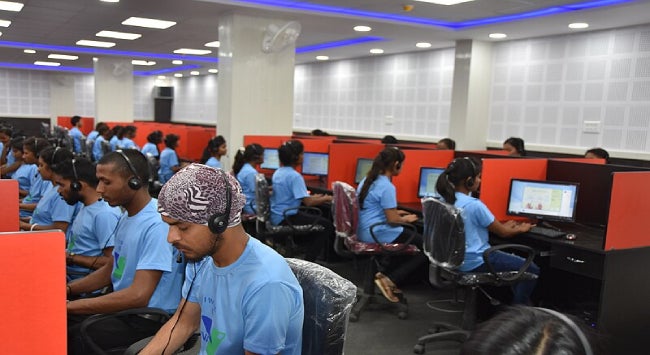Summary
Global capability centres (GCCs) are driving high growth of India’s service exports. They are imparting stability to the external sector and creating local jobs. Existing incentives should shift to encouraging more GCCs.
The latest monthly trade figures for India reveal an interesting feature. India’s export of services at US$35.7 billion (S$48.4 billion) in November 2024 is higher than its merchandise exports of US$32.11 billion (S$43.5 billion) during the same month. For the first seven months of FY2024/25 (April-November 2024), the total export of services at US$251.9 billion (S$341.5 billion) is lower than merchandise exports of US$284.3 billion (S$385.4 billion). However, service exports during the April-November 2024 period are 14.5 per cent higher than between April and November 2023 (US$220 billion [S$298.2 billion]), compared with an almost negligible growth for merchandise exports, which were US$278.3 billion (S$377.3 billion) in the April-November 2023 period.
The robust growth in service exports might mark the beginning of a new phase in India’s external trade. The drivers of this phase are the global capability centres (GCCs) that are shaping India’s emergence as a technology and innovation hub.
The Reserve Bank of India’s (RBI) statistics on quarterly balance of payments (BOP) throw more light on the services leading the export rally. During the first quarter of FY202/25 (April-June 2024), aggregate services exports were US$88.4 billion (S$119.8 billion). Among various categories of services – travel, transportation, insurance and miscellaneous services – the last one accounted for US$71.5 billion (S$96.9 billion), or around four-fifth of total service exports. Within miscellaneous services, two groups stood out: software services and business services.
Exports of software services during the April-June 2024 period were US$41.9 billion (S$56.8 billion), while those of business services were US$23 billion (S$31.2 billion). Taken together, the two services contributed to more than 90 per cent of the miscellaneous service exports. While the next quarter statistics are yet to become available, the robust growth of overall services trade during the April-November 2024 period is a sign of software and business services maintaining their good growth.
India’s proficiency in software services is well-known. Over the years, the ability has transformed. From delivering back-end solutions for outsourced business processes of global clients, the emphasis has shifted to developing front-end functions for many of the same clients. These are noticeable in software design and development, predominantly in AI, cloud computing, data analytics and semiconductors. These front-end functions, along with other supporting functions, such as engineering, accounting, procurement, human resource management and customer support, are being provided through global capability centres (GCCs).
The GCCs are driving India’s software and business service exports. There are around 1,700 GCCs in India right now, with the number projected to increase to around 2,500 by the end of the decade. The market size of Indian GCCs is projected to exceed US$100 billion (S$135.5 billion) by 2030 with their expansion creating more than 2.5 million jobs. Many of the world’s leading technological, industrial, financial and retail businesses, such as Microsoft, Deloitte, Bosch, Shell, JP Morgan, Goldman Sachs, HSBC, Citi, Amazon and Walmart, have set up GCCs in India.
With the GCC-driven service exports from India increasing rapidly, there is a distinct possibility of overall service exports rising well above merchandise exports. The trend will alter the character of India’s external trade by shifting its export-orientation towards services.
India runs a surplus in its services trade with the rest of the world. High growth in services exports is good news for its balance of payments (BOP) as that will help to reduce the overall current account deficit. The GCC-led export drive is a meaningful strategy for strengthening the BOP and generating more domestic jobs.
Some enabling conditions are necessary to ensure unhindered growth and expansion of the GCCs. These include dispersing the growth of the GCCs within the country. Right now, the GCCs are heavily concentrated in Bengaluru, followed by Hyderabad and Pune. Soon enough, these cities will start experiencing capacity constraints through higher overhead costs. It is essential to make other cities in the country, including the Tier 2 and 3 cities, attractive to global businesses for setting up GCCs. This will require the targeted cities to have high-quality information technology infrastructure, simple business regulations for setting up GCCs and availability of well-trained workforces. Karnataka’s GCC policy is an interesting example in this regard. However, not all states in India might be able to financially incentivise the growth of GCCs through seed funds, innovation fund and commercial rent reimbursements, like Karnataka is planning to. Rather than financial incentives, simplifying rules and improving business climate can be more meaningful long-term strategies for other states.
An important prerequisite for the robust growth of GCCs is policy consciousness about the importance of services in charting the future growth of the Indian economy. The economy currently has too many incentives for encouraging manufacturing. Since the size of the incentive pie cannot enlarge much further, its slices must be distributed strategically. More incentives should be targeted towards export-oriented services, including GCCs, even if it means reducing sops for some manufacturing industries.
. . . . .
Dr Amitendu Palit is a Senior Research Fellow and Research Lead (Trade and Economics) at the Institute of South Asian Studies (ISAS), an autonomous research institute at the National University of Singapore (NUS). He can be contacted at isasap@nus.edu.sg. The author bears full responsibility for the facts cited and opinions expressed in this paper.
Picture image: https://commons.wikimedia.org/wiki/File:Dantewada_Yuva_BPO.jpg
-
 More From :
More From :
-
 Tags :
Tags :
-
 Download PDF
Download PDF



